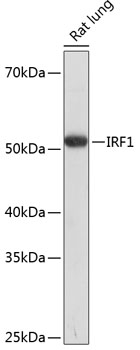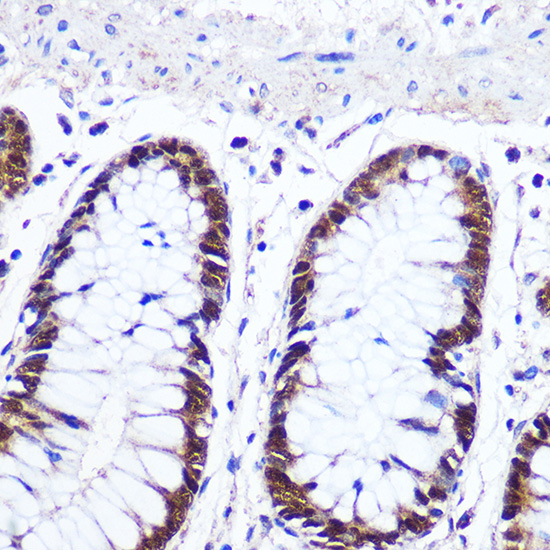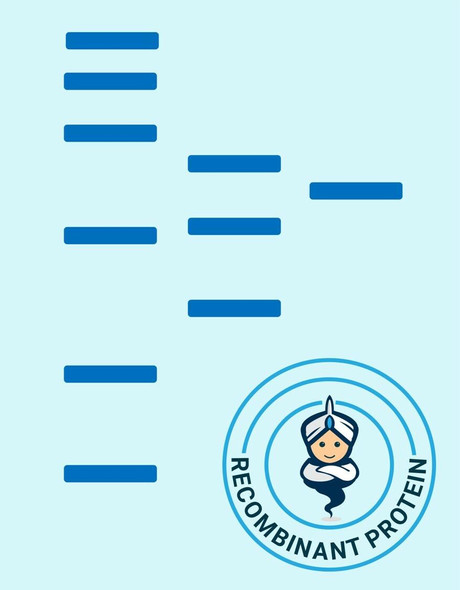Immunology Antibodies 2
Anti-IRF1 Antibody (CAB7692)
- SKU:
- CAB7692
- Product Type:
- Antibody
- Reactivity:
- Human
- Reactivity:
- Mouse
- Reactivity:
- Rat
- Host Species:
- Rabbit
- Isotype:
- IgG
- Antibody Type:
- Polyclonal Antibody
- Research Area:
- Immunology
Description
| Antibody Name: | Anti-IRF1 Antibody |
| Antibody SKU: | CAB7692 |
| Antibody Size: | 20uL, 50uL, 100uL |
| Application: | WB IHC IF |
| Reactivity: | Human, Mouse, Rat |
| Host Species: | Rabbit |
| Immunogen: | A synthetic peptide of human IRF1 |
| Application: | WB IHC IF |
| Recommended Dilution: | WB 1:500 - 1:2000 IHC 1:50 - 1:100 IF 1:50 - 1:100 |
| Reactivity: | Human, Mouse, Rat |
| Positive Samples: | Rat lung |
| Immunogen: | A synthetic peptide of human IRF1 |
| Purification Method: | Affinity purification |
| Storage Buffer: | Store at -20'C. Avoid freeze / thaw cycles. Buffer: PBS with 0.02% sodium azide, 50% glycerol, pH7.3. |
| Isotype: | IgG |
| Sequence: | Email for sequence |
| Gene ID: | 3659 |
| Uniprot: | P10914 |
| Cellular Location: | Cytoplasm, Nucleus |
| Calculated MW: | 36kDa |
| Observed MW: | 50KDa |
| Synonyms: | IRF1, IRF-1, MAR |
| Background: | IRF1 encodes interferon regulatory factor 1, a member of the interferon regulatory transcription factor (IRF) family. IRF1 serves as an activator of interferons alpha and beta transcription, and in mouse it has been shown to be required for double-stranded RNA induction of these genes. IRF1 also functions as a transcription activator of genes induced by interferons alpha, beta, and gamma. Further, IRF1 has been shown to play roles in regulating apoptosis and tumor-suppressoion. |
| UniProt Protein Function: | IRF1: a transcriptional regulator which displays a remarkable functional diversity in the regulation of cellular responses. These include the regulation of IFN and IFN-inducible genes, host response to viral and bacterial infections, regulation of many genes expressed during hematopoiesis, inflammation, immune responses and cell proliferation and differentiation, regulation of the cell cycle and induction of growth arrest and programmed cell death following DNA damage. Stimulates both innate and acquired immune responses through the activation of specific target genes and can act as a transcriptional activator and repressor regulating target genes by binding to an interferon- stimulated response element (ISRE) in their promoters. Its target genes for transcriptional activation activity include: genes involved in anti-viral response, such as IFN-alpha/beta, DDX58, TRAIL, OAS1/2, PIAS1, PKR and RSAD2; antibacterial response, such as iNOS; anti- proliferative response, such as p53, LOX and CDKN1A; apoptosis, such as PUMA, CASP1, CASP7 and CASP8; immune response, such as IL7, IL12A/B and IL15, COX-2 and CYBB; DNA damage responses and DNA repair, such as POLQ; MHC class I expression, such as TAP1, PSMB9, PSME1, PSME2 and B2M and MHC class II expression, such as CIITA. Represses genes involved in anti-proliferative response, such as survivin, CCNB1, CCNE1, CDK1, CDK2 and CDK4 and in immune response, such as FOXP3, IL4, ANXA2 and TLR4. Stimulates p53-dependent transcription through enhanced recruitment of EP300 leading to increased acetylation of p53. Plays an important role in immune response directly affecting NK maturation and activity, macrophage production of IL12, Th1 development and maturation of CD8+ T-cells. Also implicated in the differentiation and maturation of dendritic cells and in the suppression of regulatory T (Treg) cells development. Acts as a tumor suppressor and plays a role not only in antagonism of tumor cell growth but also in stimulating an immune response against tumor cells. Defects in IRF1 are a cause of gastric adenocarcinoma (GASC), accounting for most of all gastric malignant tumors. Deletions or rearrangements of IRF1 can occur in preleukemic myelodysplastic syndrome (MDS) and acute myelogenous leukemia (AML). |
| UniProt Protein Details: | Protein type:Tumor suppressor; Transcription factor Chromosomal Location of Human Ortholog: 5q31.1 Cellular Component: cytoplasm; cytosol; nuclear chromatin; nucleoplasm; nucleus Molecular Function:DNA binding; protein binding Biological Process: apoptosis; blood coagulation; cell cycle arrest; defense response to virus; negative regulation of cell proliferation; negative regulation of regulatory T cell differentiation; negative regulation of transcription, DNA-dependent; positive regulation of interferon type I production; positive regulation of interferon-beta production; positive regulation of transcription from RNA polymerase II promoter; positive regulation of transcription, DNA-dependent; regulation of adaptive immune response; regulation of cell cycle; regulation of innate immune response; regulation of MyD88-dependent toll-like receptor signaling pathway; transcription from RNA polymerase II promoter Disease: Gastric Cancer; Lung Cancer |
| NCBI Summary: | IRF1 encodes interferon regulatory factor 1, a member of the interferon regulatory transcription factor (IRF) family. IRF1 serves as an activator of interferons alpha and beta transcription, and in mouse it has been shown to be required for double-stranded RNA induction of these genes. IRF1 also functions as a transcription activator of genes induced by interferons alpha, beta, and gamma. Further, IRF1 has been shown to play roles in regulating apoptosis and tumor-suppressoion. [provided by RefSeq, Jul 2008] |
| UniProt Code: | P10914 |
| NCBI GenInfo Identifier: | 20178295 |
| NCBI Gene ID: | 3659 |
| NCBI Accession: | P10914.2 |
| UniProt Secondary Accession: | P10914,Q96GG7, |
| UniProt Related Accession: | P10914 |
| Molecular Weight: | 36,502 Da |
| NCBI Full Name: | Interferon regulatory factor 1 |
| NCBI Synonym Full Names: | interferon regulatory factor 1 |
| NCBI Official Symbol: | IRF1 |
| NCBI Official Synonym Symbols: | MAR; IRF-1 |
| NCBI Protein Information: | interferon regulatory factor 1 |
| UniProt Protein Name: | Interferon regulatory factor 1 |
| Protein Family: | Interferon regulatory factor |
| UniProt Gene Name: | IRF1 |
| UniProt Entry Name: | IRF1_HUMAN |









